Tag: Virginia Vineyards Association
Saving Our Grapes from Birds and Other Predators
Last year, as we approached harvest time, I was admiring our grapes one weekend day when I realized it was time to check the sugar levels. Unfortunately, I had left my refractometer in Fairfax, which, well, wasn’t very helpful. But not to worry. I made a mental note to bring it with me to Afton the following weekend, when I was sure that the sugar in the grapes would be just about perfect.
I remembered the refractometer, but unfortunately, I could not find the grapes. I searched the Petit Verdot rows, where I was sure I had seen small clusters hanging, and the Cab Franc rows, which I knew also had grapes hanging from the vines. But there were none to be seen.
It was kind of like the time my car was stolen at the train station in Jersey. I stared at the space where my car used to be wondering why it was no longer there, and then wandered around the parking lot as though I hoped it was magically somewhere else. Somewhere other than where I knew I had left it. Self-delusion is a terrible thing.
My car was gone, all those years ago, and last year, so were my grapes. My first thought was birds. Yeah, they love grapes, and they know when they’re ripe. They descend upon the vineyard just at the time when the brix (a measure of the sugar level) is just right, and they steal everything in sight.
Of course, it could have been other predators. It seems that all of nature has its eyes on grapevines as the harvest season grows near, and so the vineyard manager needs to be alert. Raccoons love grapes, as do squirrels and bears and crows and turkeys. As it happened, our neighbors told us about a bear they had spotted wandering through our property last year, right around the time we found a huge gash in our deer fence. Jim Parkhurst of Virginia Tech told the summer technical meeting of the Virginia Vineyards Association that a bear will sit down in the vineyard, pull clusters of grapes off the vine, and then move down the row, sit again and pull off more clusters.
But, of course, it’s hard to know for sure which predator stole my grapes. Last year was a very difficult year because of the acorn shortage. There are two types of acorns; those that come in every other year and those that come in annually. In 2013, both types failed. So squirrels especially were desperate for a meal, and vineyards were like the free sample aisle at Costco. I talked to vineyard managers who reported losing more than a third of their grapes to predators last year, which is extraordinary.
So, this year, we’re all taking precautions.
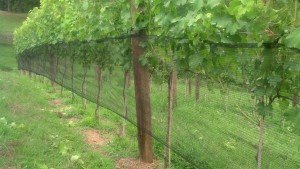
This is more or less what the netting will look like once it’s dropped. Here’, I’ve just attached it to the first catch wire on the Viognier vines, and haven’t yet rolled it up.
I spent the day Sunday (after a full day Saturday working with the Vineyard Goddess on canopy management) installing bird netting. Bird netting places a barrier between the grapes and predators, and hopefully it will be enough to preserve this year’s crop. I got about half-way through the vineyard, hanging the netting on my Viognier and Petit Verdot, and then rolling it up so that it will be out of the way until it’s needed.
I should point out that I would have also gotten the netting up on my Petit Manseng except that the Vineyard Goddess had found – I can’t even bring myself to say this – a bird nest in those rows, and asked me to wait a week or two. I wanted to rip the nest out, but I couldn’t. She’s the Vineyard Goddess, after all, and she outranks me when we’re working among with the vines.
As it turned out, I wouldn’t have gotten that far anyhow. I ran out of clips before I was quite through the Merlot, and I ran out of energy before I got to the Cab Franc. So, I ordered more clips today from Spec Trellising, and I’ll be praying next weekend that I don’t run out of netting. The roll that they shipped is 1,650 feet long, which should give me a couple of feet to spare. But who knows.
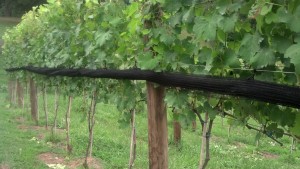
Here’s what the netting looks like after it’s rolled up, waiting until the grapes are ripe enough to attract predators.
A couple of words of advice to the weekend vintner about installing bird netting. First, don’t expect instructions. Apparently the netting doesn’t come with any. And don’t expect advice on how to install it – I didn’t get much. Also, don’t think the Internet will be of any help. I googled side-netting, bird-betting and every conceivable permutation of those terms for hours and got no help whatsoever. I did find lots of helpful advice, videos included, on different kinds of netting, especially the stuff that hangs over the trellis, creating a ceiling of sorts that you can drive a tractor underneath. But nothing for my side netting.
As it turned out, though, much to my surprise, bird netting isn’t all that hard to install.
Once I got the netting into the vineyard, and looked at the net clips, I was able to figure out (after one false start) how to do it. The clips look like tiny boat anchors, with a hook at the top to hold it to a catch wire and one hook on each side at the bottom. What I finally realized is that the back hook holds the netting on the catch wire permanently, and the front hook holds the rolled up netting (the storage position) until it’s ready for use.
I have lots of other questions, but I’ll figure it out as I go. And I ordered one more piece of equipment – small “C” hooks, which will hold the netting together at both the top and bottom to keep birds from finding a way in. I also have a tagging gun which is supposed to be a good way to zip shut the net at the bottom, but truthfully, I couldn’t figure out how to make the gun work this weekend.
I’m feeling pretty good about the netting, though. Unlike last year, I think most of my grapes will make it through to harvest. And if they don’t, it will be for reasons other than birds and other predators.
And, this is my first real harvest. As upsetting as it was to see my grapes stolen by predators last year, the fact is, it wasn’t that much of a loss. We had dropped fruit during the year to give the two-year old vines a good start in life. We wanted their energy to go toward developing a strong trunk and root system, not grapes. So, for those of you wondering exactly how many grapes were stolen, the answer is something like a half-dozen or so clusters that we missed when dropping fruit.
Not the end of the world, thank God. More like a cheap lesson for the future.
Just off the Grape Press: New Editors
It’s a pleasure to announce that the Vineyard Goddess and I are now co-editors of Grape Press, the quarterly publication of the Virginia Vineyards Association. Our first issue is the just-published Spring 2013 edition, and while we took over editorial responsibilities too late to have had any role in the planning, we spent lots of time collecting articles, working with the authors on final edits, revamping the look of page 1, and dealing with the hundreds (well, dozens and dozens) of little details that come up as you’re going to press.
We’re very excited about this opportunity for a number of reasons. First, lots of folks in the Virginia viticulture community have been 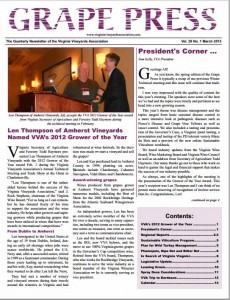 very generous with us, giving hours of their time to assist in our education. Early on, for example, I posted a note to a web site for the Central Virginia Winemakers group asking a question about how much time I should expect to set aside to manage a small vineyard I got lots of responses, and two of the folks who replied to my query hosted us at their vineyard for what amounted to a seminar on growing grapes.
very generous with us, giving hours of their time to assist in our education. Early on, for example, I posted a note to a web site for the Central Virginia Winemakers group asking a question about how much time I should expect to set aside to manage a small vineyard I got lots of responses, and two of the folks who replied to my query hosted us at their vineyard for what amounted to a seminar on growing grapes.
Secondly, we’re big fans of Virginia wine. We attended our first Virginia wine festival some 25 years ago, and while the wines weren’t great back then, some were pretty good, and we thought they all had promise. We were right. The wines got better each year, and today, we think Virginia wines have really come into their own. Virginia Viognier is a world-class wine. Cab Franc, Merlot, Petit Verdot, Petit Manseng, Norton and a number of other grape varieties have been made into truly great wines. My personal view is that a number of the Commonwealth’s wineries are making wines that can compete anywhere in the world, and their ranks are growing each year.
A major reason for the continued improvement in Virginia wine is the quality of the fruit that wineries have to work with. As the old saying goes, wine is made in the vineyard. And the quality of the fruit is improving in no small part because of the willingness of so many in the business to help each other out. In this industry, people share knowledge. Grape Press is part of that process, and the Vineyard Goddess and I are thrilled to be able to play a part, however small, in the continued growth of the Virginia wine industry
As I said, we can’t take credit for the range of high-quality stories in the current edition, but we did have a chance to work with the authors, and it was one of the best journalistic experiences of my life. The writers were all involved in one aspect or another of viticulture, from the distinguished vineyard consultant Lucie Morton to grape pathologist Mizuho Nita to Ankida Ridge vineyard owner Christine Vrooman.
The writers were knowledgeable and intelligent, and their articles were infused with personality and wit, which made them a pleasure to read. I won’t try to mention everything from this issue, but Christine Vrooman’s series on sustainability, Andrew Hodson’s article comparing French and Virginia Viognier, and Jim Benefiel’s story on a VVA expedition to Bordeaux are among those I would recommend to anyone. And honestly, there isn’t a bad article in the whole issue. Bill Freitag, Katie Hellebush, Pete Johns, Lucie Morton, Mizuho Nita and Dean Triplett contributed excellent articles, and they’re all worth a read. For what it’s worth, I read the entire issue, word for word, at least twice, and I enjoyed it as much on the final read as I did on the first round of edits.
Membership in the Virginia Vineyards Association is a must for anyone involved in the Virginia wine industry. But Grape Press is great resource for anyone interested in viticulture, no matter where you live. It’s a great publication, and Chris (the Vineyard Goddess) and I will be doing our very best to ensure hat it continues to be great.
Every Grape is Different — Notes from a Vineyard Conference
The Virginia Vineyards Association brings together commercial grape growers, hobbyists and others with an interest in viticulture, and its efforts to promote cooperation and the exchange of information is one of the reasons that the Commonwealth’s wine gets better every year. I believe, and I think most of the growers who participated in the association’s technical meeting in Charlottesville last week would agree, that the reputation of Virginia wine is influenced by every bottle that’s sold. If someone has a bad experience the first time they taste a Virginia wine, they may never try another. So all of us have a vested interest in doing what we can to help each other make the best wine possible.
Another reason for the success of the Virginia wine industry is the work that’s being done at Virginia Tech by folks like Tony Wolf, Bruce Zoecklein, and Mizuho Nita, all of whom played major roles at the meeting. Tony Wolf’s book, Wine Grape Production Guide for Eastern North America, has become our bible as we move toward planting a small hobby vineyard, and Mizuho Nita’s blog is the indispensible guide to grape disease management.
However, this was my first encounter with Dr. Zoecklein, and I’m hopeful now that it won’t be my last. Dr. Zoecklein has written the book (actually, at least four books and too many articles to count) on wine chemistry, and he manages to make the chemistry both accessible and practical for people like me. And since this was a class on “Sensory Evaluation for Grape Growers,” he taught the class through the tastes and aromas of seven separate wines, which we tasted blind throughout the class. Continue Reading–>

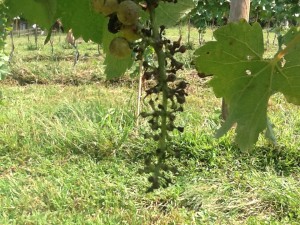
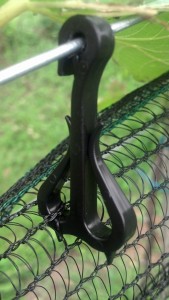



Recent Comments